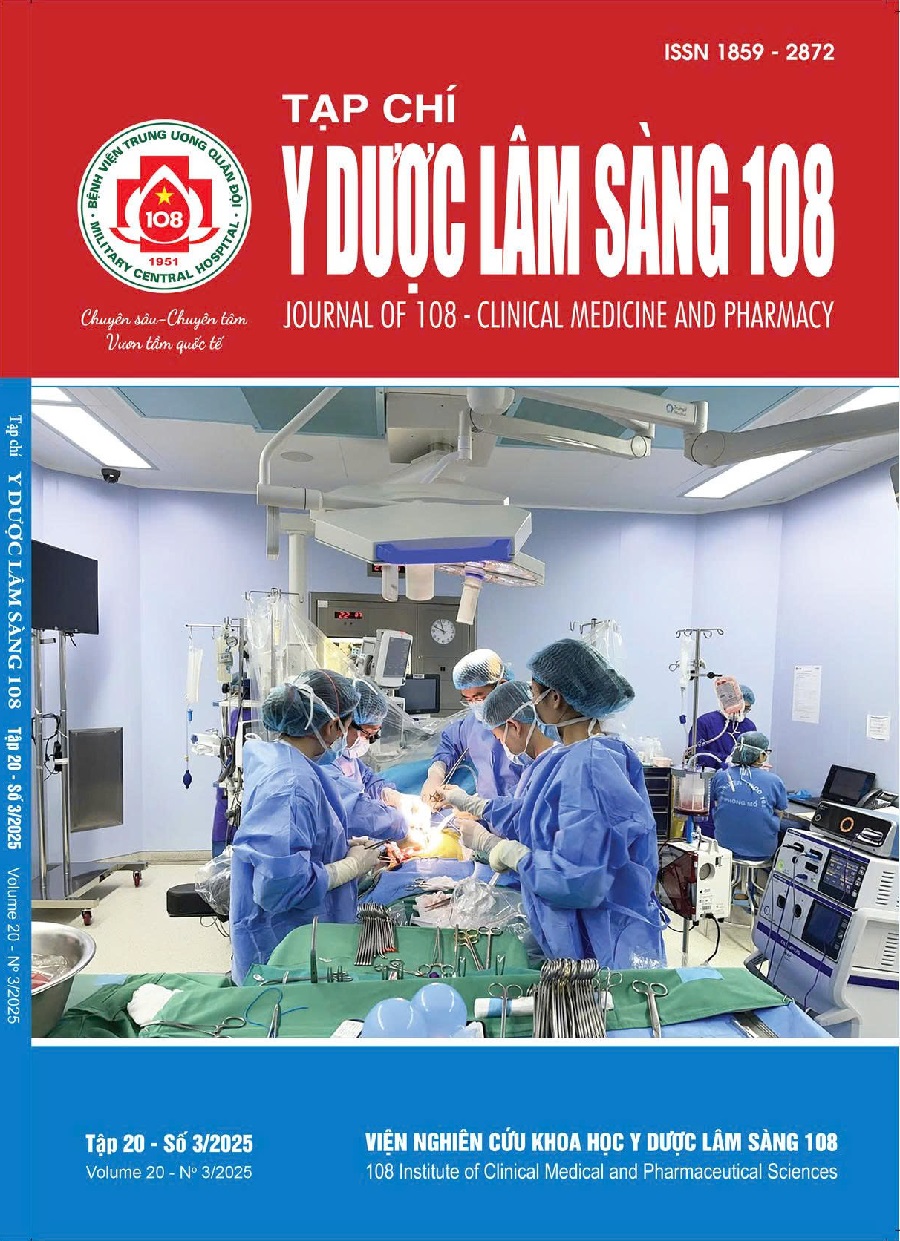Nghiên cứu đặc điểm kiểu hình của tổn thương thận cấp liên quan đến nhiễm khuẩn huyết
Main Article Content
Keywords
Tóm tắt
Mục tiêu: Khảo sát đặc điểm kiểu hình của tổn thương thận cấp liên quan đến nhiễm khuẩn huyết (SA-AKI) và mối liên quan với mức độ nặng của tổn thương thận cấp (AKI) theo ADQI 28. Đối tượng và phương pháp: Nghiên cứu mô tả tiến cứu trên 212 bệnh nhân nhiễm khuẩn huyết và sốc nhiễm khuẩn tại Bệnh viện Trung ương Quân đội 108. Kết quả: Tỷ lệ bệnh nhân SA-AKI chiếm 67,5%. SA-AKI sớm chiếm 86,0%; SA-AKI muộn chiếm 14,0%. Nhóm có SA-AKI sớm có nồng độ creatinin cao hơn [170 (136-256) so với 107 (67-125) mcmol/l], p<0,05 và có tỷ lệ AKI nặng cao hơn nhóm phát hiện SA-AKI muộn với p<0,05. Kết luận: SA-AKI khá phổ biến ở những bệnh nhân bị nhiễm khuẩn huyết và sốc nhiễm khuẩn, thường xuất hiện trong vòng hai ngày sau khi nhập viện từ cấp cứu. SA-AKI sớm có tỷ lệ AKI nặng cao hơn SA-AKI muộn.
Article Details
Các tài liệu tham khảo
2. Zarbock A, Nadim MK, Pickkers P et al (2023) Sepsis-associated acute kidney injury: Consensus report of the 28th Acute Disease Quality Initiative workgroup. Nat Rev Nephrol 19(6): 401-417. doi:10.1038/s41581-023-00683-3.
3. Lima RS, Marques CN, Silva Júnior GB et al (2008) Comparison between early and delayed acute kidney injury secondary to infectious disease in the intensive care unit. Int Urol Nephrol 40(3): 731-739. doi:10.1007/s11255-008-9352-9.
4. White KC, Serpa-Neto A, Hurford R et al (2023) Sepsis-associated acute kidney injury in the intensive care unit: incidence, patient characteristics, timing, trajectory, treatment, and associated outcomes. A multicenter, observational study. Intensive Care Med 49(9): 1079-1089. doi:10.1007/s00134-023-07138-0.
5. Monard C, Bianchi N, Kelevina T, Altarelli M, Schneider A (2024) Epidemiology and outcomes of early versus late septic acute kidney injury in critically ill patients: A retrospective cohort study. Anaesth Crit Care Pain Med 43(1): 101332. doi:10.1016/j.accpm.2023.101332.
6. Singer M, Deutschman CS, Seymour CW et al (2016) The Third International Consensus Definitions for Sepsis and Septic Shock (Sepsis-3). JAMA 315(8): 801-810. doi:10.1001/jama.2016.0287.
7. KDIGO (2012) KDIGO Clinical Practice Guideline for Acute Kidney Injury. Kidney International Supplements. vol 2 | supplement 1.
8. Rewa O, Bagshaw S (2014) Acute kidney injury—epidemiology, outcomes and economics. Nat Rev Nephrol 10: 193–207. https://doi.org/10.1038/nrneph.2013.282.
9. Poukkanen M, Vaara ST, Pettilä V et al (2013) Acute kidney injury in patients with severe sepsis in Finnish Intensive Care Units. Acta Anaesthesiol Scand 57(7): 863-872.
10. Wiersema R, Jukarainen S, Vaara ST et al (2020) Two subphenotypes of septic acute kidney injury are associated with different 90-day mortality and renal recovery. Critical Care 24:1-10.
11. Maiden MJ, Otto S, Brealey JK et al (2016) Structure and function of the kidney in septic shock. A prospective controlled experimental study. American journal of respiratory and critical care medicine 194(6): 692-700.
12. Maslove DM, Tang B, Shankar-Hari M et al (2022) Redefining critical illness. Nature medicine 28(6): 1141-1148.
13. Göcze I, Jauch D, Götz M et al (2018) Biomarker-guided intervention to prevent acute kidney injury after major surgery: The prospective randomized BigpAK study. Ann Surg 267(6):1013-1020.
14. Meersch M, Schmidt C, Hoffmeier A et al (2017) Prevention of cardiac surgery-associated AKI by implementing the KDIGO guidelines in high risk patients identified by biomarkers: the PrevAKI randomized controlled trial. Intensive care medicine 43: 1551-1561.
 ISSN: 1859 - 2872
ISSN: 1859 - 2872
